Physical Address
304 North Cardinal St.
Dorchester Center, MA 02124
Physical Address
304 North Cardinal St.
Dorchester Center, MA 02124
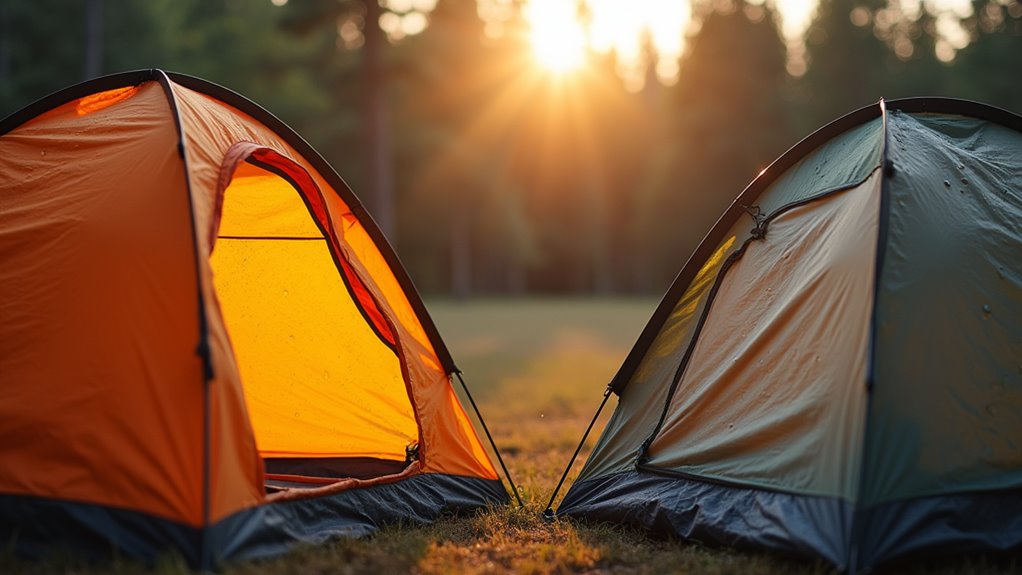
Discover why that $30 tent might cost you more than money—the shocking truth about cheap camping gear could save your next adventure.
Most campers don’t realize there’s a vital difference between “cheap” and “budget-friendly” tents—and choosing wrong could leave you soaked, shivering, or stranded with broken gear. You’re probably tempted by those $30 tents at big-box stores, but before you grab one, you’ll want to understand what corners manufacturers cut to hit rock-bottom prices. The answer isn’t always “spend more,” but knowing when to save versus when to invest could make or break your outdoor adventures.
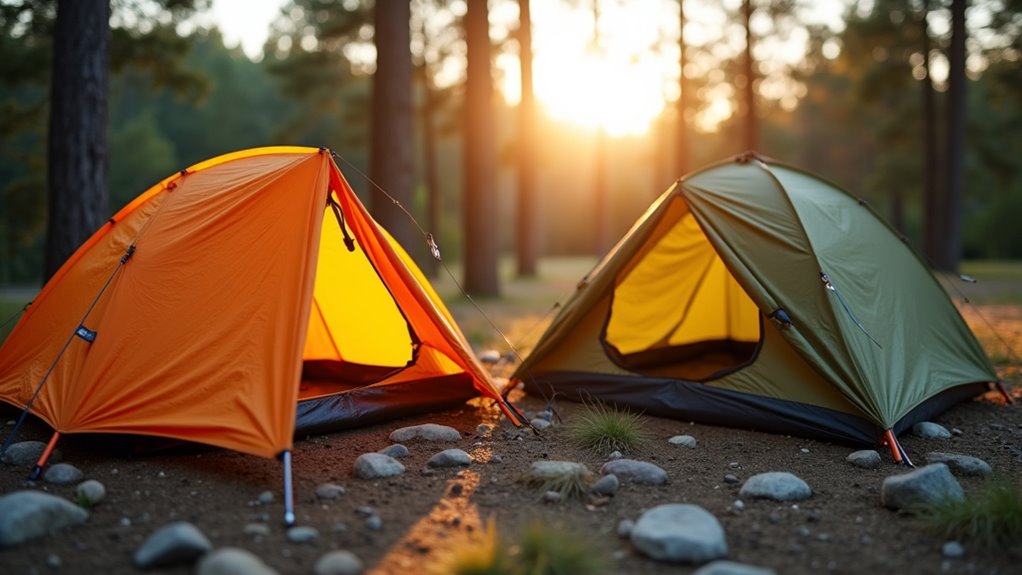
There’s a crucial difference between cheap and budget-friendly when you’re shopping for camping tents. Cheap tents prioritize rock-bottom prices over everything else, often using flimsy materials that’ll leave you soaked and miserable after one storm. You’ll find paper-thin fabrics, weak zippers, and poles that bend under light wind.
Budget-friendly tents, however, offer genuine value. They balance cost with essential features you actually need. You’re getting decent waterproofing, sturdy construction, and reliable hardware without premium bells and whistles.
The key difference? Cheap tents cost you more long-term through frequent replacements and ruined camping trips. Budget-friendly options serve you well for years while respecting your wallet. Don’t confuse low price with smart spending – they’re completely different approaches to gear selection.
Just like choosing quality equipment matters for advanced skiers tackling challenging terrain, selecting reliable camping gear ensures your outdoor adventures aren’t cut short by equipment failure.
When manufacturers slash tent prices, they’ll cut corners in predictable ways that directly impact your camping experience.
You’ll notice thinner fabrics that tear easily and don’t handle wind well. Zippers become flimsy plastic instead of sturdy metal, jamming when you need them most. Seams aren’t properly sealed, letting water seep through during rain.
The frame uses weaker aluminum or fiberglass poles that bend or snap under stress.
Cheap tents often skip waterproof coatings or use inferior materials that fail after minimal exposure.
You’ll find fewer guy-out points for stability, smaller vestibules, and poor ventilation that creates condensation problems. Stakes are usually lightweight and bend in hard ground.
These compromises mean you’ll likely replace your tent sooner, potentially costing more long-term than buying quality upfront. Before making any purchase decision, research what features matter most for your specific camping needs and consider how often you’ll actually use the tent to determine if the initial investment in higher quality is worthwhile.
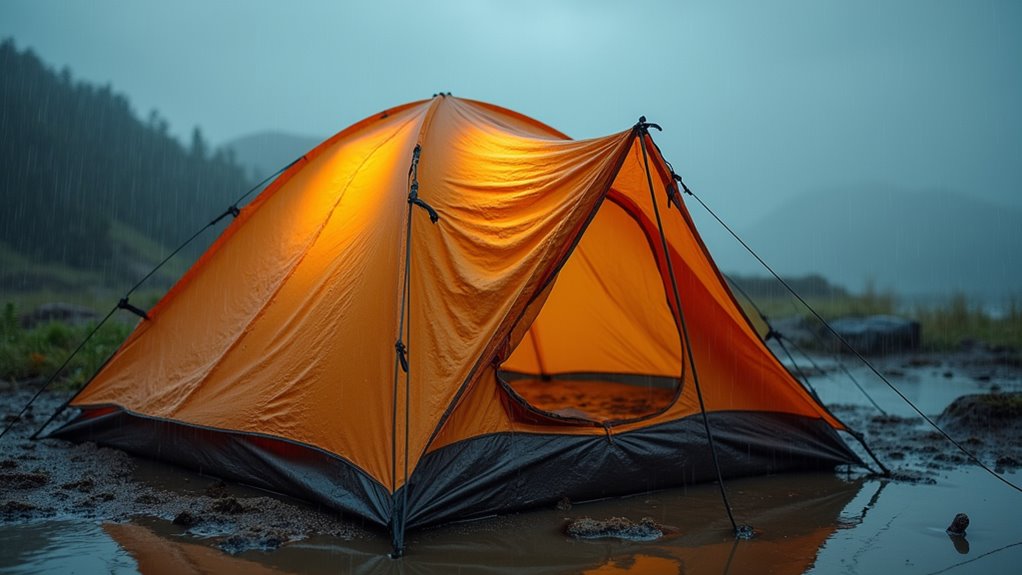
While your cheap tent might look sturdy in the store, real weather conditions expose its limitations fast. You’ll discover that budget tents struggle most with water resistance. Their seams aren’t properly sealed, and the fabric coating degrades quickly, leaving you soaked during moderate rain.
Wind resistance becomes another nightmare. Cheap poles bend or snap under pressure, and flimsy stakes pull out easily. You’ll find yourself fighting to keep your shelter upright when gusts hit.
Temperature regulation also suffers. Poor ventilation creates condensation problems, while thin materials offer little insulation. Your tent becomes a sauna in summer heat or an icebox during cold nights.
In areas where insects are prevalent, budget tents often lack proper mosquito nets or have poorly constructed mesh that tears easily, leaving you vulnerable to bites throughout the night.
These weather performance issues transform what should be comfortable camping trips into survival situations you’d rather avoid.
Budget tents typically last one to two seasons before major components fail, though your camping frequency and care habits directly impact this timeline. You’ll notice zippers jamming first, followed by fabric tears at stress points and pole breakage during setup. Seams often separate after repeated use, especially where guy-lines attach.
If you camp occasionally—maybe three weekends per year—a cheap tent might serve you adequately for several seasons. However, frequent campers should expect replacement costs to mount quickly. You can extend lifespan by storing your tent completely dry, avoiding over-tensioning guy-lines, and packing carefully to prevent pole damage.
Consider cost-per-use calculations: a $50 tent lasting two seasons versus a $200 tent lasting eight seasons makes the pricier option more economical for regular campers. Just like with recreational vehicles, avoiding common buying mistakes helps ensure you make the most cost-effective choice for your outdoor adventures.
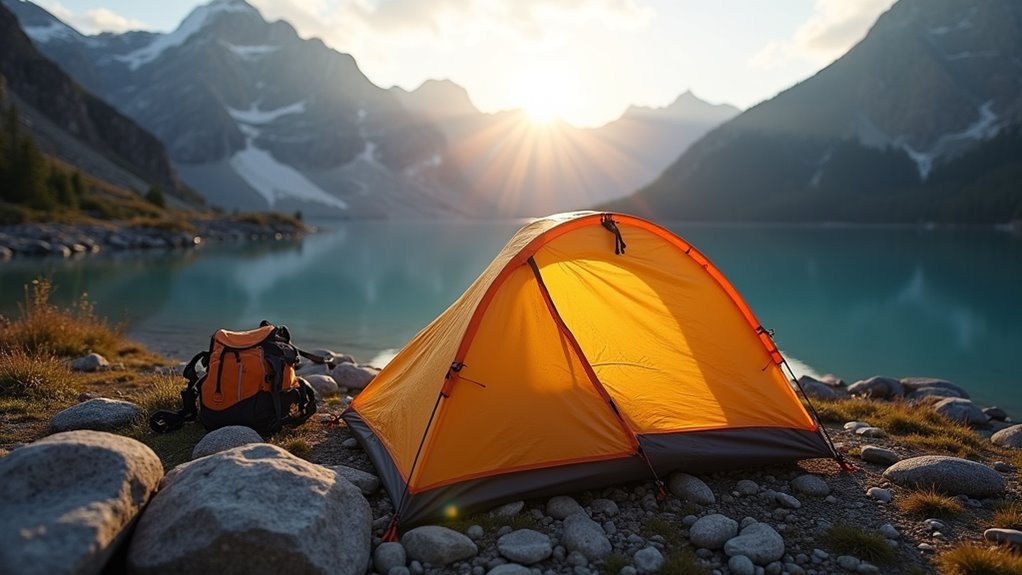
Despite their limitations, cheap tents serve specific situations exceptionally well. If you’re camping once or twice annually, spending hundreds on premium gear doesn’t make financial sense. You’ll get adequate shelter without breaking your budget.
For occasional campers, cheap tents offer adequate shelter without the hefty price tag of premium gear.
Beginner campers should start cheap while learning preferences and camping styles. Why invest heavily before knowing if you prefer backpacking or car camping? Cheap tents let you experiment affordably.
They’re perfect for festivals, beach trips, or situations where theft’s possible. You won’t stress about leaving a $50 tent unattended like you’d a $300 model.
Parents introducing kids to camping benefit too. Children might damage gear accidentally, and cheap tents reduce that financial sting while kids develop outdoor responsibility.
For emergency preparedness or backup shelter, cheap tents provide reasonable protection without major investment.
Places like Alpine, Wyoming offer numerous camping opportunities where a budget tent can serve you well while you explore both adventurous and relaxing outdoor experiences.
Though saving money upfront seems smart, rock-bottom tent prices often lead to expensive surprises down the trail. You’ll likely face replacement costs when your $30 tent tears after three trips. That broken zipper you can’t fix? Another $40 tent purchase.
Weather failures create bigger expenses. When your ultra-cheap tent leaks during a weekend trip, you’re paying for emergency motel rooms or gear replacements for soaked sleeping bags. Food spoilage from inadequate shelter adds up too.
Poor durability means you’ll buy multiple tents instead of one decent option. A $150 tent lasting five years costs less than three $50 tents over the same period.
Factor in gas money for return trips to replace failed gear, and those “bargain” tents become budget killers. Just like deciding whether to rent or buy outdoor equipment, weighing long-term costs against upfront savings helps you make the smartest financial choice.
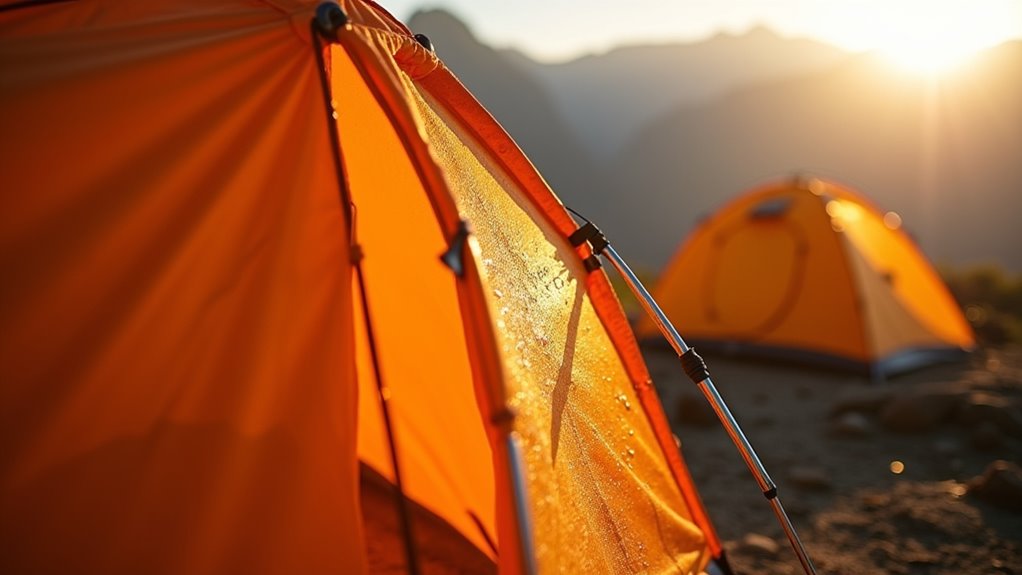
When you’re ready to invest a bit more in your camping tent, certain features deliver genuine value that justifies the extra cost. Quality waterproofing protects you from soggy nights and damaged gear. Look for tents with taped seams and higher hydrostatic head ratings—they’ll keep you dry when cheap alternatives fail.
Aluminum poles outlast fiberglass ones by years, resisting breaks in wind and handling repeated setup without snapping. You’ll save money long-term by avoiding replacements.
Vestibules provide essential gear storage space, keeping muddy boots and wet equipment outside your sleeping area.
Color-coded clips and intuitive pole systems make setup faster, especially after dark or in bad weather.
Double-wall construction offers better ventilation and temperature control than single-wall designs, reducing condensation that makes cheap tents uncomfortable.
Whether you’re traditional tent camping or setting up alongside RVers at established campgrounds, investing in quality features ensures your shelter performs reliably across different camping styles.
While your budget determines which tents you’ll consider, smart shopping strategies help you get the most tent for your money regardless of what you’re spending. Shop end-of-season sales when retailers clear inventory at steep discounts. Check customer reviews thoroughly – they’ll reveal real-world performance issues manufacturers won’t mention.
Compare weight-to-space ratios to ensure you’re not paying for unnecessary bulk. Look for tents with versatile features that serve multiple purposes, like vestibules doubling as gear storage. Consider slightly used gear from reputable outdoor retailers or rental companies.
Don’t ignore lesser-known brands that often offer comparable quality at lower prices. Focus on essential features for your camping style rather than bells and whistles you won’t use. Remember that even budget-friendly camping tents can provide reliable shelter when you prioritize fundamental construction quality over premium features.
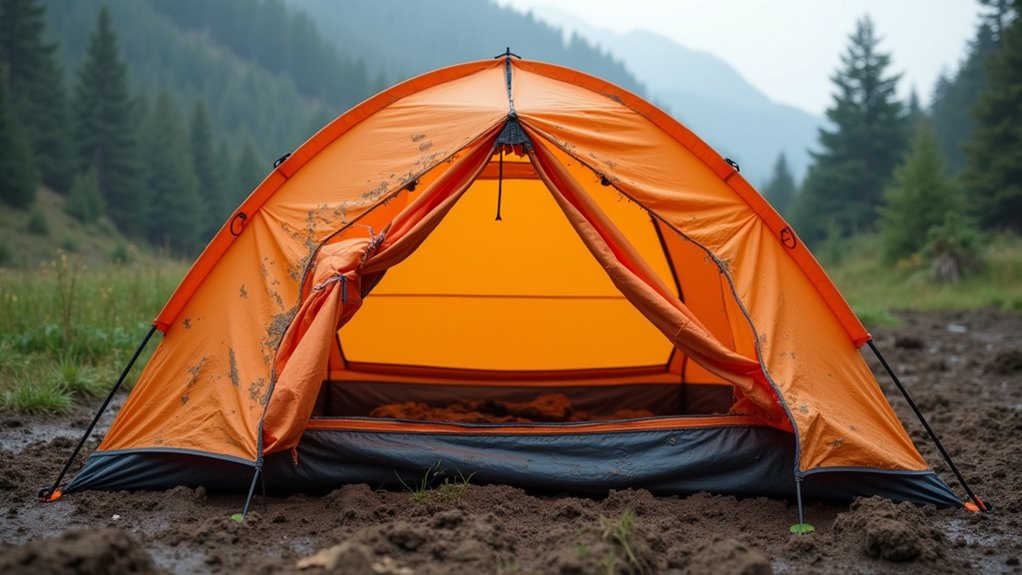
Smart shopping tactics will only get you so far if you fall for common traps that plague the budget tent market. You’ll want to steer clear of these warning signs that signal poor quality or deceptive marketing.
Don’t let these red flags ruin your camping experience. Consider investing in quality gear for memorable experiences like church camp activities where reliable shelter is essential.
You’ll either be sleeping like royalty under the stars or drowning in your own tent when that budget nightmare collapses at 2 AM during a thunderstorm. Don’t let rock-bottom prices turn your camping dreams into soggy disasters – you’re not saving money if you’re replacing your tent every season. Invest smart, sleep dry, and avoid becoming that camper who’s duct-taping their shelter together while everyone else stays cozy.